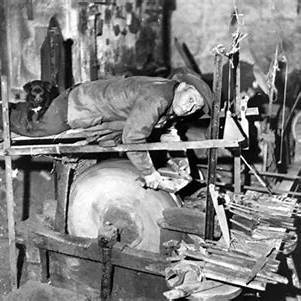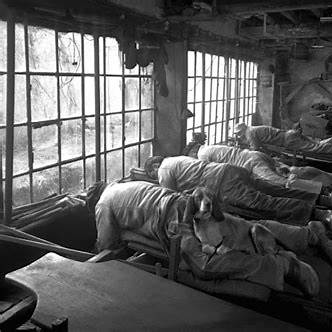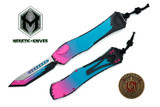Hidden Lives in Steel: The Prone Grinders of Thiers (and Their Dogs)



In the early 1900s, amid the steep hills and flowing Durolle waters of Thiers, France, blade production was both art and endurance. Here, in factories and small workshops, craftsmen refined their blades in one of the most unusual postures in industrial history: lying prone over the grinding wheels.
Rather than stooping or bending, these men stretched their bodies calm and flat, pressing chest and abdomen to a bench suspended above the wheel. The technique had a grim practicality: it spared their spines from the chronic strain of bending over a stone day after day. At a glance, the scene looks almost theatrical — a man defying gravity, face-down over steel.
Yet the quietest detail makes the image unforgettable: dogs curled upon their legs. In archival images and narrative accounts, these animals sat or lay there as if guarding or sharing the work. They absorbed warmth from the human body, blocked drafts from cold stone floors, and offered companionship in the endless hours of grinding. Some captions describe the practice as encouraged (or at least permitted) by workshop foremen in colder months. knives-of-france-blog.com+4Mechtraveller+4Rare Historical Photos+4
Thiers’ rise as a cutlery capital had paradoxes. The region lacked iron ore deposits and fine grindstone material, yet it leveraged the Durolle’s hydraulic power and a dense concentration of skilled artisans to build a massive knife industry. Over centuries, Thiers refined every stage of blade production — from forging and filing to polishing and assembly — often assigning separate specialists to each step. Claude Dozorme+4Amusing Planet+4Mechtraveller+4
By the early 1900s, thousands labored in the Durolle valley’s factories — known locally as the Vallée des Usines (Valley of Factories). Wikipedia+2Mechtraveller+2 The grindstone benches, often set low and long, became a field of motion: the rhythmic arc of a blade, the dust that settled like snow, the silent weight of men brushing their steel.
While some modern retellings exaggerate the posture as purely “upside-down,” the reality is that the craftsmen lay prone — face to the stone, not inverted. And the presence of dogs, while attested in many photo captions and popular accounts, remains more anecdotal than fully documented in archival labor records.
Still, the image holds power: a craftsman defying wear, a blade sharpened under steady hand, and a dog’s quiet vigil at his legs. They speak of toil, adaptation, and a bond between man, steel, and beast that transcended daily routine.
Recent Posts
-
Hidden Lives in Steel: The Prone Grinders of Thiers (and Their Dogs)
In the early 1900s, amid the steep hills and flowing Durolle waters of Thiers, France, blade prod …Oct 6th 2025 -
The Heretic Hydra V4 OTF: A Bold New Miami Vice Edition
Few knives capture the imagination of collectors like the Heretic Hydra series. For years, the Hydra …Aug 28th 2025 -
Precision Edge Craft: Knife Sharpening
Precision Edge Craft: Mastering Knife Angles for Optimal PerformanceIn the realm of cooking, sharp k …Nov 13th 2023

